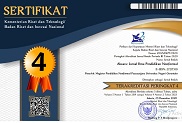Tay Kak Sie Temple: A Building Structure with a Style Influenced by Chinese Culture
Abstract
Keywords
Full Text:
PDFReferences
Alieffudin, Muhammad Nizar. 2018. “Makna Arsitektur Klenteng Teng Swie Bio Di Kecamatan Krian , Sidoarjo.†AntroUnair (2):151-66.
Cheng, Muhammad, and H. O. Purbalingga. 2014. “Masjid Jami Piti Laksamana Simbol Keindahan Toleransi.†Jurnal Kebudayaan Islam Vol. 12(No. 1):27-39.
Creswell, John W. 2014. Penelitian Kualitatif Dan Desain Riset. 3rd ed. edited by S. Z. Qudsy. Yogyakarta: Pustaka Pelajar.
Creswell, John W., and Vicky L. Plano Clark. 2018. Designing and Conducting Mixed Methods Design. Third Edit. edited by C. Neve. Los Angeles: SAGE Publication In.
Kustedja, Sugiri, Antariksa Sudikno, and Purnama Salura. 2013. “Makna Ikon Naga, Long é¾™ , é¾ Elemen Utama Arsitektur Tradisional Tionghoa.†Jurnal Sosioteknologi 12(30):526-39.
Leavy, Patricia. 2017. Reseach Design: Quantitative, Qualitative, Mixed Methods, Arts-Based, and Community-Based Participatory Research Approaches. 1st ed. edited by P. Leavy. New York: The Guilford Press.
Liesawan, Tresiyani Mettasari, and Jesseline Carissa Novita. 2021. “Analisis Tata Ruang Dan Makna Simbolis Ragam Hias Binatang Pada Klenteng Tulus Harapan Kita (Thian Huo Kiong) Gorontalo.†Jurnal Desain Interior 6(1):25.
Mustaqin, Khairul. 2014. “Ornamen Liong Pada Atap Kelenteng Di Jawa Tengah Dan Diy: Studi Kasus Kelenteng Tay Kak Sie, Kelenteng Tien Kok Sie, Dan Kelenteng Tjen Liong Kiong. KIONG.†Institut Seni Indonesia (ISI) Surakarta.
Nuratri, Ruth Kiana. 2022. “Overview of Tien Kok Sie Temple in Solo City, Indonesia.†MANDARINABLE: Journal of Chinese Studies Language, Literature, Culture, and Journalism 01(01):17-21.
Rizky, Amanda. 2019. “Re-Aktualisasi Kisah Perjalanan Laksamana Cheng Ho Di Cirebon Melalui Batik (Kajian Batik Di Cirebon Serta Hubungannya Dengan Bahasa Rupa Tradisi).†Corak 8(1):27-42.
Suparno, Antonius. 2017. “Memaknai Kembali Tradisi Wayang Potehi.†Jurnal Litera 16(2):189-202.
Taylor, Steven J., Robert Bogdan, and Marjorie L. DeVault. 2016. Qualitative Reseach Methods. 4th Editio. Canada: John Wiley & Sons, Inc.
Yin, Robert K. 2018. Case Study Research and Applications: Design and Methods. Sixth. Singapore: Sage Publication Inc.
DOI: http://dx.doi.org/10.37905/aksara.9.2.825-832.2023
Refbacks
- There are currently no refbacks.
Copyright (c) 2023 Aksara: Jurnal Ilmu Pendidikan Nonformal

This work is licensed under a Creative Commons Attribution-ShareAlike 4.0 International License.
Publisher:
Magister Pendidikan Nonformal Pascasarjana Universitas Negeri Gorontalo
Jl. Soedirman No. 06 Gorontalo 96128 e-mail: jurnalaksara@ung.ac.id
http://ejurnal.pps.ung.ac.id







